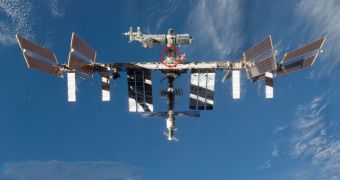The six astronauts that are currently making up the Expedition 24 crew to the International Space Station (ISS) have in their care a number of scientific experiments that could have vast influences on the future of mankind. One of them is DECLIC-HTI, and its makers say that it could hold the key towards enabling specialists to improve the methods they are using to treat household and nuclear wastes. The fluid physics study is still underway, and experts are eager to get its conclusions as soon as possible, ScienceDaily reports.
The miniaturized, automatic thermo-optical laboratory that houses the DEvice for the study of Critical LIquids and Crystallization (DECLIC) contains transparent fluids. Researchers analyze these materials by tweaking some of their parameters, such as for instance the temperature of a sample. As soon as readings of a certain state of the liquid are collected, they are sent back to Earth, and the astronaut crew moves to modify the parameters. The HTI component, also called the high temperature insert, is a tool that allows experts to measure temperatures exceeding 400 degrees Celsius, inside the fluid.
The goal of the investigation is to collect more data on supercritical fluids, which represent a state of matter in which water (for example) reaches temperatures and pressures that would normally exceed its critical point. In other words, when water goes supercritical, it can still dissolve materials like a liquid, but it can pass through objects as a gas. This ability could be of tremendous use back on Earth, especially for the development of advanced methods of cleaning wastes in treatment plants, or in nuclear energy-powered facilities. Nuclear residues are notoriously difficult to clean or store, as they require special structures to be built specifically for this task.
The phenomena astronauts aboard the ISS are currently observing “will be of interest to understand the behavior of supercritical fluids in space, but also to improve industrial processes on the ground. A typical example is burning completely organic or industrial waste in supercritical water at a much lower temperature than in conventional systems, thus saving energy and being cleaner. Microgravity will provide the ideal environment to understand how to do that,” explains Centre National d'Etudes Spatiales (CNES) DECLIC mission manager Gabriel Pont.
“We expect HTI to give us the best measurement of this temperature ever found. We are very excited about what we've seen thus far, and cannot wait to see the potential benefits of our work on Earth,” the expert concludes.

 14 DAY TRIAL //
14 DAY TRIAL //